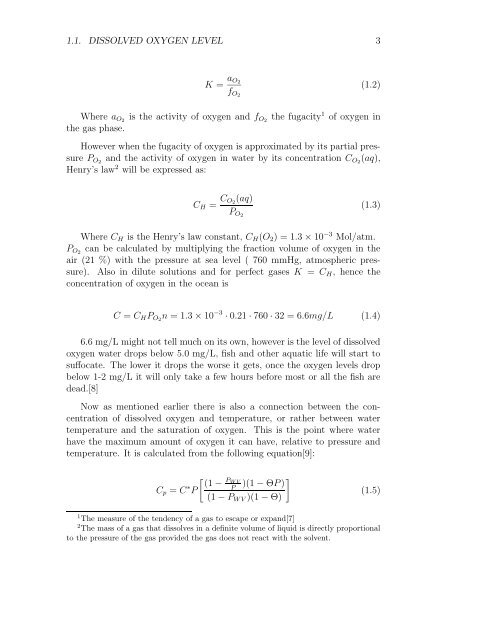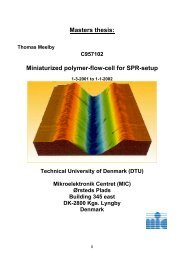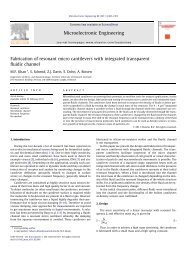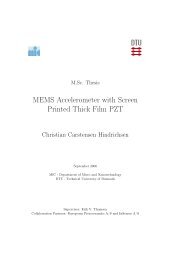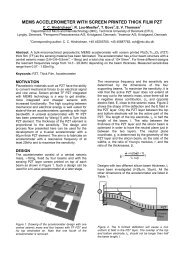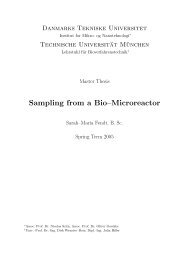Development of a Oxygen Sensor for Marine ... - DTU Nanotech
Development of a Oxygen Sensor for Marine ... - DTU Nanotech
Development of a Oxygen Sensor for Marine ... - DTU Nanotech
Create successful ePaper yourself
Turn your PDF publications into a flip-book with our unique Google optimized e-Paper software.
1.1. DISSOLVED OXYGEN LEVEL 3<br />
K = aO2<br />
fO2<br />
(1.2)<br />
Where aO2 is the activity <strong>of</strong> oxygen and fO2 the fugacity 1 <strong>of</strong> oxygen in<br />
the gas phase.<br />
However when the fugacity <strong>of</strong> oxygen is approximated by its partial pressure<br />
PO2 and the activity <strong>of</strong> oxygen in water by its concentration CO2(aq),<br />
Henry’s law 2 will be expressed as:<br />
CH = CO2(aq)<br />
PO2<br />
(1.3)<br />
Where CH is the Henry’s law constant, CH(O2) = 1.3 × 10 −3 Mol/atm.<br />
PO2 can be calculated by multiplying the fraction volume <strong>of</strong> oxygen in the<br />
air (21 %) with the pressure at sea level ( 760 mmHg, atmospheric pressure).<br />
Also in dilute solutions and <strong>for</strong> perfect gases K = CH, hence the<br />
concentration <strong>of</strong> oxygen in the ocean is<br />
C = CHPO2n = 1.3 × 10 −3 · 0.21 · 760 · 32 = 6.6mg/L (1.4)<br />
6.6 mg/L might not tell much on its own, however is the level <strong>of</strong> dissolved<br />
oxygen water drops below 5.0 mg/L, fish and other aquatic life will start to<br />
suffocate. The lower it drops the worse it gets, once the oxygen levels drop<br />
below 1-2 mg/L it will only take a few hours be<strong>for</strong>e most or all the fish are<br />
dead.[8]<br />
Now as mentioned earlier there is also a connection between the concentration<br />
<strong>of</strong> dissolved oxygen and temperature, or rather between water<br />
temperature and the saturation <strong>of</strong> oxygen. This is the point where water<br />
have the maximum amount <strong>of</strong> oxygen it can have, relative to pressure and<br />
temperature. It is calculated from the following equation[9]:<br />
Cp = C ∗ <br />
PW V (1 − )(1 − ΘP )<br />
P P<br />
(1 − PW V )(1 − Θ)<br />
(1.5)<br />
1 The measure <strong>of</strong> the tendency <strong>of</strong> a gas to escape or expand[7]<br />
2 The mass <strong>of</strong> a gas that dissolves in a definite volume <strong>of</strong> liquid is directly proportional<br />
to the pressure <strong>of</strong> the gas provided the gas does not react with the solvent.


